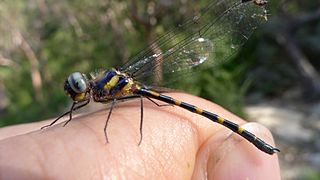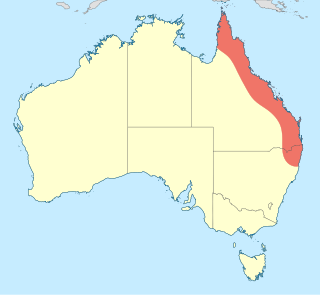
Austrocordulia is a genus of dragonfly in the superfamily Libelluloidea, endemic to northern and eastern Australia. Species of Austrocordulia are medium-sized, dark-coloured dragonflies, either brown or black with yellow markings.

Ictinogomphus is a genus of dragonflies in the family Gomphidae. They are medium to large, yellow and black with clear wings. Species occur in Africa, Asia and Australia.

Lathrocordulia is a genus of dragonfly in the superfamily Libelluloidea, endemic to Australia. Species of Lathrocordulia are medium-sized, bronze to black dragonflies without pale markings,

Petalura is a genus of very large dragonflies in the family Petaluridae. Species of Petalura are brown or black with yellow markings and usually clear wings. The anal appendages of the males are broad and leaf-like giving them their common name of petaltails. They are endemic to south-western and eastern Australia.

Archaeophya is a small genus of dragonflies assigned to the superfamily Libelluloidea. Species of Archaeophya are large dragonflies with metallic-coloured bodies, dark with yellow spots, and clear wings. They only occur in eastern Australia.

The Synthemistidae are the family of dragonflies commonly known as tigertails, or sometimes called southern emeralds. This family is part of the superfamily Libelluloidea.

Choristhemis is a genus of small dragonflies in the family Synthemistidae found in eastern Australia. They are small to medium-sized slender dragonflies with dark colouring and light markings and a relatively weak flight.
Telephlebiidae was once regarded as a separate family of dragonflies that were endemic to eastern and south-western Australia. However, recent taxonomic revisions have resulted in the classification of species that were previously placed in Telephlebiidae to now be part of the family Aeshnidae.

Cordulephya is a genus of dragonflies assigned to the superfamily Libelluloidea, and endemic to eastern Australia. The species are small to tiny in size, coloured black, or purplish-black, with yellowish markings. Unusually for Anisoptera, these dragonflies rest with their wings folded above their body in a similar manner to many species of damselfly. They are commonly known as shutwings.
Cordulephyidae was formerly considered a distinct family of dragonflies occurring in Africa and Australia. Recent taxonomic revisions have classified the species previously placed in Cordulephyidae to now be within the superfamily Libelluloidea.
Up until recently, Lindeniidae was considered a family of dragonflies occurring in Australia. It is no longer recognised.
Brachytronidae was formerly considered a distinct family of dragonflies occurring in Australia. Up until recently, Dendroaeschna had been its only genus, and that is now placed in the family Aeshnidae. Brachytronidae is no longer recognised.
Austrocorduliidae was formerly considered a family of dragonflies occurring in South Africa and Australia. Recent taxonomic revisions have classified the species previously placed in Austrocorduliidae to now be within the superfamily Libelluloidea.

Apocordulia is a genus of dragonflies in the superfamily Libelluloidea, endemic to the Murray-Darling Basin in eastern Australia.

Austrophya mystica, known as a rainforest mystic, is a species of dragonfly in the superfamily Libelluloidea, endemic to north-eastern Australia.

Hesperocordulia is a genus of dragonflies in the superfamily Libelluloidea, endemic to south-western Australia.

Micromidia is a genus of dragonflies in the superfamily Libelluloidea. They are small to medium-sized dragonflies, coloured black or metallic green with pale markings, and endemic to eastern Australia.

Austrocordulia refracta is a species of dragonfly in the superfamily Libelluloidea, commonly known as the eastern hawk. It is a medium-sized, dull brown dragonfly, endemic to eastern Australia, where it inhabits streams and pools.

Austrophya is a genus of dragonflies in the superfamily Libelluloidea, endemic to north-eastern Australia.
Gomphomacromiidae was formerly considered a distinct family of dragonflies occurring in Chile and Australia. Recent taxonomic revisions have classified the species previously placed in Gomphomacromiidae to now be within the superfamily Libelluloidea.












